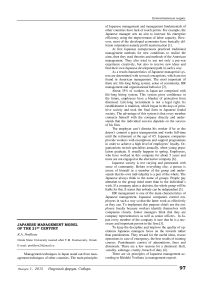Japanese management model оf the 21st century
Автор: Perfilova K.A.
Журнал: Научный форум. Сибирь @forumsibir
Рубрика: Экономика
Статья в выпуске: 1 т.1, 2015 года.
Бесплатный доступ
Короткий адрес: https://sciup.org/140220237
IDR: 140220237
Текст статьи Japanese management model оf the 21st century
Management techniques in Japan stand out from management techniques of other countries. The main principles of Japanese management and management fundamentals of other countries have lack of touch points. For example, the Japanese manager sets an aim to increase his enterprise efficiency using the improvement of labor capacity. However, most of the developed economies have basically different orientation namely profit maximization [1].
At first Japanese entrepreneurs practiced traditional management methods for new conditions to realize the aims, then they used theories and methods of the American management. They also tried to use not only a pre-war experience creatively, but also to receive new ideas and find their own Japanese development path in such a way.
As a result characteristics of Japanese managerial system are determined with several conceptions, which are not found in American management. The most important of them are: life-long hiring system, sense of community, HR management and organizational behavior [2].
About 35% of workers in Japan are comprised with life-long hiring system. This system gives confidence in the future, employees have a blanket of protection from dismissal. Life-long recruitment is not a legal right. Its establishment is tradition, which began in the days of primitive society and took the final form in Japanese feudal society. The advantage of this system is that every member connects himself with the company directly and understands that the individual success depends on the success of his firm.
The employer can’t dismiss his worker if he or she doesn’t commit a grave transgression and works full-time until the retirement at the age of 65. Japanese companies provide workers with exemptions and support programmes in order to achieve a high level of employees’ loyalty. Organizations recruit specialists annually, when young population graduate. It usually happens in spring. Employees, who have worked in this company for about 5 years and more are not engaged at the alternative company [6].
Japanese society is not varying and penetrated with sense of community. Before everything else, a person is aware of himself as a member of the group and understands that his own individuality is a part of the whole. The Japanese always think in the name of groups. People pay attention to the group mind more than to the individual’s wish. If a company takes a decision, the whole group will be liable for this. It seems that nobody can be independent [3].
HR management is one of the main characteristics of Japanese management. Japanese companies control employees in such a way so that the latter work as effectively as they can. To implement this purpose chiefs use the employee loyalty because workers identify themselves with companies closely. Junior managers think that they are company representatives as well as senior officers. In Japan every member of the company is sure that he is a necessary and important person in the firm [3].
To keep the discipline and improve the quality of operations Japanese managers focus on the rewards rather than punishments. They reward for the useful ideas, rescue operations in case of emergency, the best results of training courses. Punishments consist of admonitions, fines and dismissals. There are a few reasons for a dismissal: theft, venality, sabotage, cruelty, breach of duty [4].
There are six principles of Japanese management according to Khideki Yosihara (a management expert).
-
1. Employment security and making a trust atmosphere. These guarantees help to reduce the employee turnover and stabilize the labour force.
-
2. Publicity and corporate values. Corporate responsibility and involvement atmosphere begin to develop when all management levels and working people use corporate information resources about company policy.
-
3. Management based on information. Japanese managers pay particular attention to data acceptance and regular use of information.
-
4. Management focused on the quality. Company’s work with the highest quality is the pride for every Japanese manager.
-
5. Permanent attendance of executive group. The Japanese frequently place senior managers in the production floors for briefing and implementing innovations, which accrue gradually.
-
6. Housekeeping. Cleanliness and neatness are fundamental reasons of high-quality goods in Japan [5].
So we considered the basic aspects of current Japanese management model in general. Japanese management cultures helped us to understand that management techniques in Japan are different from the others. It is a phenomenal control system.
Список литературы Japanese management model оf the 21st century
- Geronin N. Japan: what is life-long hiring//Union, 1990.
- Komarov S. Japanese phenomenon roots//Economics and life, 1997
- Ouchi W. Methods of industrial organization: Russian and American. -M.: Science, 1993.
- Shreder G. Lead according to situation/transl. from German M.: Progress, 1994.
- Vahrushev V. Principles of Japanese management. -M.: Progress, 1992.
- http://psyfactor.org/personal/personal15-04.htm


